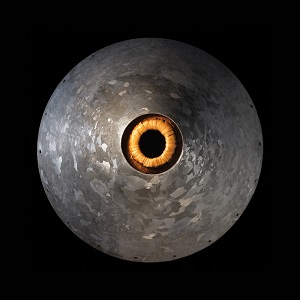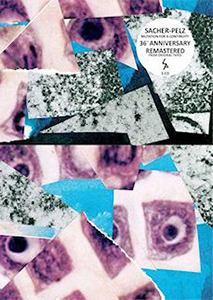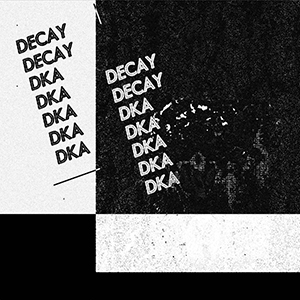- Administrator
- Albums and Singles
MUTATION
... the lunatics are running the asylum ...
Physically: A Mutation occurs when a DNA gene is damaged or changed in such a way as to alter the genetic message carried by that gene.
Mentally: Anything goes ... and it does.
Another collaboration from Steven Stapleton and Graham Bowers exploring their unique world of music is to be released later this month ... however the first 60 will be a limited edition containing a special original artwork, numbered and signed by Steven ... we have intentionally kept the price as low as possible ... for details follow the links below where it can be pre-ordered:
http://www.red-wharf.com/shop.htm
for audio excerpts and sleeve artwork go to
http://www.red-wharf.com/Nurse%20With%20Wound%20and%20Graham%20Bowers.htm

Read More
- Administrator
- Albums and Singles

In honour of The Emerald Isle's big day, Fovea Hex is proud to present The Slow Slow Air.
http://foveahex.bandcamp.com/album/the-slow-slow-air
“I've always loved the Slow Airs – to me they are the jewels in the crown of Irish traditional music. As an experiment, I extracted various phrases from a few Slow Airs, slowed them down, and wove them together into a quasi-fugue. My friend Justin Grounds (justingrounds.com) recorded them on baroque violin, and this became The Slow Slow Air. For Skibbereen Arts Week last year, I used The Slow Slow Air as the soundtrack to a little movie I made on my iPhone, gradually, over the course of a year or two – it's a time-lapse collage of scenes from the walk I take every day, up the hill behind the house and through the townland of Aghadown.......”
As a St. Patricks Day Special, we're making The Slow Slow Air available on Bandcamp as a pay-what-you-wish download. You can also watch the movie on our YouTube channel : youtu.be/Gt4N9RHKUX8
credits
Trad. Arr. Clodagh Simonds (c) 2015
feat. violin Justin Grounds
film editing Eavan Aiken
Read More
- Administrator
- Albums and Singles
 A reissue of their debut full length LP, this self-titled album by Austin’s S U R V I V E has the quartet presenting nine distinct synth based compositions that run the gamut between prog experimentation, abstract space, and new wave-esque beats and rhythms. Their stylistic choices and approach to music are both pretty clear, but succeed where many others just try to latch on and ride out the wave of synth nostalgia prevalent these past few years.
A reissue of their debut full length LP, this self-titled album by Austin’s S U R V I V E has the quartet presenting nine distinct synth based compositions that run the gamut between prog experimentation, abstract space, and new wave-esque beats and rhythms. Their stylistic choices and approach to music are both pretty clear, but succeed where many others just try to latch on and ride out the wave of synth nostalgia prevalent these past few years.
As someone with an affinity for a snappy drum machine and a simple, but catchy sequencer line, "Floating Cube," having a slightly loose melody and tight rhythm programming, immediately grabbed my attention.With just the right amount of self-aware '80s nostalgia, it works rather well, embracing just enough of the style without trying too hard.On "Hourglass," percolating keyboards and rigid drums appear covered in a vintage haze of faded colors and time-worn magnetic tape.
"Black Mollies" has the band trying different structures within the same sonic palette, utilizing a slightly abstract start/stop pacing, in a complex composition that never stays in one place too long, but does not feel as if it is jumpy or inconsistent either."Omniverse" also sees the band segueing into darker moods via a slower pace and sparser mix, first showcasing the sharp drums and then the synth leads at the conclusion.
On a few of the songs, they drop the rhythms entirely and instead focus on slowly drifting and expanding synth pads and melodies.Opening piece "Deserted Skies" introduces the album with a cavernous and wide open sound throughout, until a pulsing rhythmic keyboard sequence pops up in its latter moments."To Light Alone I Bow" has a vaguely new age sound to it, but tastefully done as to avoid falling into the standard clichés.
The album comes to a fitting climax on "Dirge," with a pace befitting its title.It may have a depressive tempo, but the big, crashing drums and bombastic, soaring synthesizers are anything but dour.The song sits somewhere between a film intro theme circa 1983 and an expansive progressive rock masterpiece.Subtle it may not be, but it is exactly within that pomp and drama that the brilliance shines through.
S U R V I V E's album may have an intentionally vintage sound to it, and that sound being one that a multitude of artists have co-opted and subgenres have sprung up around.Unlike many of those projects though, it does not come across as a gimmick or bandwagon jumping at all.Those 1980s new wave elements we all know:raw synths, inhuman drum machines, and reverb heavy atmospheres all feature heavily here, but paired with a strong sense of composition and effective production, it stands out brilliantly amongst a field of pretenders.
samples:
 
Read More
- Administrator
- Albums and Singles
 A collaboration between Kouhei Matsunaga (who has worked with everyone from Sensational to Autechre and Asmus Tietchens) and the less prolific Toshio Munehiro, NHK’s ultra minimalist approach to techno may conjure memories of the late 90s/early 2000s glitch and microsound scenes, but their combination of erratic beats and digital expanses feels anything but dated, sounding entirely unique and fresh in 2015.
A collaboration between Kouhei Matsunaga (who has worked with everyone from Sensational to Autechre and Asmus Tietchens) and the less prolific Toshio Munehiro, NHK’s ultra minimalist approach to techno may conjure memories of the late 90s/early 2000s glitch and microsound scenes, but their combination of erratic beats and digital expanses feels anything but dated, sounding entirely unique and fresh in 2015.
I have always had a soft spot for that short lived era that was often full of derided laptop musicians and a style that was akin IDM taken to an even further point of abstraction.So when the glitch claps and broken AM radio house synth stabs of "Ch. 2" locked into a tight groove I was pretty thrilled.On "Ch. 6" the duo works with similar components but into a more microscopic click beat framework.Made up of a series of interlocking loops, it has the essential repetition of dance music while still building and evolving the whole time to be anything but monochromatic.
Those two make for perhaps the most conventional rhythms and sounds that NHK put together here.Beats show up in other places as well, such as the wet gymnasium basketball thud of "Ch. 1" or the simple analog synth-like thump of "Ch. 3".An unconventional bit of rhythm underscores the skittering noises and simple melodies on "Ch. 5", resulting for an exceptionally strong combination.
The beat oriented pieces may be the most memorable in a conventional music sense, but when the duo abandon that and go completely into experimental sounds it is no less fascinating.Shrill noises and weird open ambient moments in "Ch. 4" are offset by speaker decimating low end drones that are as easily felt as heard.On "Ch. 8" the two string together a series of electronic hums and the occasional bit of jarring digital interference noise with a backing of what could pass for a rhythm, but is made up of a bizarre collection of tiny sounds that could just as easily be extracted from field recordings as they could be the product of extreme digital signal modeling.
One of the thing that makes Program succeed so well is Matsunagaand Munehiro’s diversity in composition.Minimalist robotic techno, ambient space and electro-acoustic compositional vibes all appear throughout, keeping the song to song progression diverse and varied, but while still sounding consistently and thematically linked to one another.The genre that is most befitting this album may not be as prominent anymore, but Program is as strong as any of those albums ever were.
samples:
 
Read More
- Administrator
- Albums and Singles
 Secrecy and solitude are the twin engines spinning at the heart of Cores/Eruct, Noé Cuéllar and Joseph Kramer's first record on their own Category of Manifestation label. By the time album opener "Bluing" has ended and "Son Form" has begun its unusual cyclic canter, they have already constructed an enigmatic and isolated atmosphere. Though clearly recorded and rigorously performed, Coppice’s songs bewilder. They teeter on the edge of the familiar and flirt with recognition, but are comprised of sounds that evade identification. Those sounds are microscopic, magnified to the point of seclusion, and hermetic, as if trapped inside a great machine churning endlessly in the dark. That sense of perpetuity is what drives the the album. It plays out like an aural mise en abyme, each song, sound, and passage opening upon some aspect itself and spiraling endlessly in a confusion of levers, springs, and eerie melodies.
Secrecy and solitude are the twin engines spinning at the heart of Cores/Eruct, Noé Cuéllar and Joseph Kramer's first record on their own Category of Manifestation label. By the time album opener "Bluing" has ended and "Son Form" has begun its unusual cyclic canter, they have already constructed an enigmatic and isolated atmosphere. Though clearly recorded and rigorously performed, Coppice’s songs bewilder. They teeter on the edge of the familiar and flirt with recognition, but are comprised of sounds that evade identification. Those sounds are microscopic, magnified to the point of seclusion, and hermetic, as if trapped inside a great machine churning endlessly in the dark. That sense of perpetuity is what drives the the album. It plays out like an aural mise en abyme, each song, sound, and passage opening upon some aspect itself and spiraling endlessly in a confusion of levers, springs, and eerie melodies.
Bluing, a household product used to whiten clothes, is also the name of a process by which steel is protected against rust. The reason for its name is obvious. As a result of the iron powder or iron oxide used in the cleaning, the affected material takes on a blue complexion. "Bluing" has a similar effect on Cores/Eruct. It sets the stage for the strange and disconcertingly cryptic music that follows, music that is structured, repetitive, and translucent, and at the same time colored by ambiguity, variety, and opacity. Whatever Cuéllar and Kramer did when recording these songs, all of them compositions dating from between 2009 and 2012, it left behind a cold, woozy feeling and a dusky, unearthly glow.
The deliberate qualities in Cores/Eruct arise from Coppice’s compositional severity. These songs feature just a few sound sources and, in some cases, utilize only a few rhythmic variations. Much depends on minute changes and subtle additions. "Son Form," for instance, focuses on a single rasping figure, which turns and grinds repetitively from start to finish, becoming longer or shorter as time goes on. It sounds a little like an uncooperative engine with a faulty pull cord for a starter. This central element pans from the right to the left channel as minute noises chirp around it, but the main revolving structure stays the same throughout. "While Like Teem or Bloom Comes (Tipping)," the album’s 13 minute centerpiece, is more diverse—it is composed of more parts— but it shifts through a fixed number of identifiable sets: a melodic, somewhat droning sound, the click-clack of plastic keys against wheezing valves and escaping air, the rattle of a metal grille paired with whistling reeds and humming wooden pipes, the surface noise of plastic buzzing against plastic. This modular approach produces a controlled and song-like impression (think verses and choruses, exposition and development), emphasizing the compositional aspect of Coppice’s repertoire.
The same elements that produce that schematic quality are also responsible for the album’s most inscrutable traits. After a time, all of those whirling movements and looping parts blur and condense. The music feeds on itself, swells, and caves in, creating a bottomless sensation that is both mesmerizing and unsettling. It is less like falling into darkness and more like falling into a massive hall of mirrors; there should be a source for all of these images, but only more reflections keep coming. If there is a ghost in the machine, if someone is responsible for setting all of these events in motion, they stay constantly out of reach, haunting the music instead of staking a claim in it.
As with many of Coppice’s recordings, recycled and remixed elements play a significant role. A recognizable fragment from last year’s Vinculum (Coincidence) shows up on "Son Form," and there are likely other bits that have been pulled from the band’s deep well of sounds. This compounds the music’s fractal quality and cultivates its botanical, not-quite-wholly determined traits. Songs on Cores/Eruct grow and leap out of themselves carrying some semblance of their prior iteration with them. The arc of their evolution can be estimated at the right distance, but the details are difficult to measure precisely. Cuéllar and Kramer are responsible for performing the songs, but their content grows of its own accord and the music burrows into places the musicians could have never guessed.
samples:
 
Read More
- Administrator
- Albums and Singles
 Before Maurizio Bianchi was recording as M.B., or under his own name, he released a series of four tapes as Sacher-Pelz. In a short span between August 1979 and March 1980, his output showed the development from seemingly random, sloppy tape manipulations into something structured and composed, and a direct precursor to what would define Bianchi's work in the early 1980s. Reissued for the material’s 36th anniversary and expanded with the M.B. Plays Sacher-Pelz album, this set captures material that is both historically relevant, and exceptionally strong proto-noise music.
Before Maurizio Bianchi was recording as M.B., or under his own name, he released a series of four tapes as Sacher-Pelz. In a short span between August 1979 and March 1980, his output showed the development from seemingly random, sloppy tape manipulations into something structured and composed, and a direct precursor to what would define Bianchi's work in the early 1980s. Reissued for the material’s 36th anniversary and expanded with the M.B. Plays Sacher-Pelz album, this set captures material that is both historically relevant, and exceptionally strong proto-noise music.
The first four discs were previously released by a subsidiary of Alga Marghen, who also did the two ArcheoMB boxes in the late 1990s.This set specifies that it is remastered from the original tapes, but not having the original box set I am not sure how they compare.Being lo-fi cassette tapes recorded at home, a certain analog sheen (more like a fuzzy blur) covers these tapes.The earliest material, Cainus, is where this is most obvious.A claustrophobic, bass heavy rumble covers all seven pieces, with what sounds like pre-recorded music or synth sequences being sped up or slowed down via tape, sometimes coming to a complete and abrupt stop without following any overt sort of structure or template.
Even as soon as the second tape, Venus, Bianchi's work shows major strides forward in terms of structure and composition.The lengthy "La Cartilage Palpitant" has him blending deep thumping rhythms and radar beacon-like electronic pulses into a mass that slowly evolves and expands throughout its duration."Chains & Whips" (Bianchi was establishing his identity in the genre, and like many artists flirted with sexually deviant imagery) has a similar trajectory, beginning with an erratic stuttering rhythm that is slowly fleshed out with echoing synth noises and distortion.A piece such as "Numb Creature" demonstrates more of his expanding compositional skill, but still mixed with a lot of rudimentary, basic tape effects.
A few months later, on the Manson-centric Cease to Exist (again trying to find his niche), Bianchi's working with a wider array of electronic sounds, and relying less on his penchant for start/stop tape manipulations.The faster paced, jerky "In Dem Tod-Tal" has an almost thrashy edge to it that at times is reminiscent with the contemporary SPK single "Slogun", though admittedly buried deep amongst heavy bass and processing.Even though obvious bits of electronic organ may shine through, "Exterminas" results in mostly a sustained wall of harsh noise type piece.The bulk of the piece is layers of static laden distortion and sheets of white noise, hinting at the sound he would expand upon soon after.
With the final tape, Velours, the sound he would take on a year later as M.B. with Symphony for a Genocide becomes rather apparent.The 31 minute "Excitements" is a amalgamation ofpunchy distorted rhythms and what sounds like heavily effected piano in a grey, bleak composition that evolves and develops brilliantly throughout.The dense industrial crunch of "Sans Sang" and thudding drum machine of "Orphelin" also foreshadow the dark, depressive atmospheres he would soon become synonymous with, and continues to be to this day.
This newer reissue of the Sacher-Peltz material contains a fifth disc, M.B. Plays Sacher-Pelz, recorded in 2008.From the bits of glitch and digital stuttering I hear throughout these three lengthy pieces, I am going to assume that Bianchi constructed this material via a dual deck DJ CD player setup, working with the original work as source material.The result is a series of pieces that, while repetitive, have him finding memorable rhythmic segments in the originally murky, raw pieces.The structure may differ, but Bianchi hardly changes the original oppressive atmospheres (other than the end of the third untitled piece) and thus this added material, recorded 28 years after the fact, still feels like it belongs.
Maurizio Bianchi's work as M.B. during the early 1980s may be what he is most well known for, and those early albums are inarguably ones that helped to shape and define the genres we know of as noise, power electronics, and industrial.This work as Sacher-Pelz is Bianchi trying to find his artistic identity, and honing both compositional skills and thematic approach to his sound, so these works are not as cohesive or powerful as what proceeded them.However, they are far more than just historical curiosities, and make for extremely strong early industrial experiments in their own right.
samples:
 
Read More
- Administrator
- Albums and Singles
 Atlanta's DKA Records has been quietly issuing vinyl for the past few years that sits on the outside of conventional techno or electronic music. Impeccable quality with an appropriately dark edge, they received a bump in notoriety last year issuing High-Functioning Flesh's debut album, which made waves into the conventional industrial/EBM world. This compilation, featuring them amongst other label luminaries, has a nice throwback feel while sounding anything but dated.
Atlanta's DKA Records has been quietly issuing vinyl for the past few years that sits on the outside of conventional techno or electronic music. Impeccable quality with an appropriately dark edge, they received a bump in notoriety last year issuing High-Functioning Flesh's debut album, which made waves into the conventional industrial/EBM world. This compilation, featuring them amongst other label luminaries, has a nice throwback feel while sounding anything but dated.
The title of the record alone made me think back to those early 80s compilations like Rising from the Red Sand or The Elephant Table Album.Current industrial darlings HFF lead off with "Confuse the Call", a dance floor stomp consistent with the strongest songs on their debut.Gurgling low quality samples, jagged Ensoniq synths by Greg Vand, and a catchy, memorable chorus by Susan Subtract (who does the best "yeah!" and "ok!", second only to perhaps Lil' Jon) has all the makings of another hit for them.The duo reappear on the flip side of the record with the Dva Damas edit of "Touch Oblivion Icon", which strips the song down to its most basic vocal fragments, deep kicks and a truckload of dubby echo and delay throughout.
The 1980s nostalgia feel pops up with a few other contributors here as well.TWINS' "A Hero’s Body, A Human's Heart" rides on taut analog sequences and up front 80s Oingo Boingo-esque quirky vocals distill the best of that neon-tinged cyberpunk vision of the future.The lengthy "The Red Dress (Parts 1 & 2)" from Tifaret emphasizes the darker edge of new wave, rather than the more conventional pop sounds.Drums seething with reverb and dramatic, nearly goth vocals blend with a mess of industrial clang and chaos, conjuring bits of the Sisters of Mercy and Skinny Puppy without sounding like either one. RedRedRed's "An Unrelenting Hour" is cut from a similar cloth, with pseudo British vocals, a wonderfully raw synth lead, and a more laconic tempo.
On a song like Tannhäuser Gate's "Pulse", the label’s more techno and dance floor oriented sounds come through strong.With a throbbing beat and brilliant bassline, bouncing from dense to minimalist arrangements while featuring heavily filtered vocals, it could work just as well in the club as it would in a more focused listening session.Xander Harris' "Protoculture" heavily utilizes stuttering kick drums and overdriven keyboard leads to again feel slightly more techno-like, but peppered with dialog samples throughout in lieu of conventional vocals.
Considering the quality of the material on here (and the previous releases on DKA) I hope that this compilation, propelled by the rising popularity of High-Functioning Flesh, will push the label into the spotlight.With an underground aesthetic, but professional quality in terms of both sound and presentation, the artists showcased on this compilation deserve a more significant amount of exposure.
samples:
- High-Functioning Flesh - "Confuse the Call"
- TWINS - "A Hero's Body, A Human's Heart"
- Tifaret - "The Red Dress"
 
Read More
- Administrator
- Albums and Singles

Culled from the vaults of WFMU—the world’s most acclaimed free-form radio station—comes over 20 hours of mind-bending, hilarious phone calls between the renowned comedy duo of Tom Scharpling & Jon Wurster. From 2000 to 2013, their tremendous imaginations took over the WFMU airwaves every Tuesday night with bizarre tales from a fictional town called Newbridge, NJ and the desperate denizens that inhabit it.
Included inside this definitive collection are 75 calls over 16 compact discs, edited by Scharpling & Wurster (over 18 of them previously unreleased or unaired), a 108-page hardcover book with cover art by Joe Matt that features essays by Patton Oswalt, Julie Klausner, Damian Abraham (lead singer of F*cked Up) and Best Show associate producer Michael Lisk (aka A.P. Mike), a definitive interview with Scharpling & Wurster by Jake Fogelnest, notes on the evolution and inspiration behind each bit written by Scharpling & Wurster, a USB drive with all of the calls plus 4 hours of bonus material, a fold-out map of Newbridge, Philly Boy Roy & Timmy von Trimble Paper Dolls, postcards, and temporary tattoos with The Best Show catch-phrases.
For everyone that pre-orders the boxed set at numerogroup.com they will literally get a piece of history - everybody gets a portion of Jon Wurster’s smashed telephone that he used to make the Rock, Rot & Rule phone call, along with a tiny letter of authenticity. Pre-orders placed after January 1, 2015 will receive their phone piece with the shipped product.
More information can be found here.
Read More
- Administrator
- Albums and Singles

Colleen is French multi-instrumentalist Cecile Schott, who uses her voice and the treble viola da gamba (a baroque instrument with gut strings), to weave intricate stories about the human mind and heart. Captain of None is the most melodic album in her repertoire, with fast-paced tracks rooted down by prominent bass lines and assorted percussive effects. It is also an album that breaks new ground for Colleen in terms of production. While previous works centered around sample-based or looped, minimal compositions, on Captain of None Schott significantly changed her approach, setting her viola and her voice as focal points. Captain of None is inhabited by delicately crafted, other-worldly pop songs incorporating dub-inspired techniques.
Captain of None was recorded, mixed, and produced entirely by Schott in her music studio in San Sebastian, Spain. Schott tried to open the gates in the way she played, sang, and wrote lyrics for the album, and set out to explore how effects like delay and echo could go from the "cosmetic sound varnish" role they usually play to a fully dynamic, constructive, song-shaping role.
Although the influence of Jamaican music is subtle, its implicit impact is felt throughout Captain of None. As a child, Schott became enamored with a cassette tape of Lee Perry tracks from 1976 to 1979. She continued to explore the music of Jamaica, awed by the amount and the variety of incredible music that was recorded with such breathtaking inventiveness. This infatuation can be heard on tracks like "Eclipse," where Schott utilizes some of the more common dub production techniques, such as using an echo effect on the percussion and vocals. Her love of Augustus Pablo can be felt on "Salina Stars," in which Schott uses the melodica, an instrument that she played for years but never used on her albums. She incorporates a Moogerfooger delay pedal to create vocal feedback and analog glitches, and used homemade devices — chopsticks, an Indonesian metal printing block — as percussion.
As for her unique main instrument of choice, Schott first noticed the viola da gamba in the film Tous les matins du monde when she was 15 years old. The instrument, which has been said to be the musical instrument that most resembles the sound of the human voice, heavily resonated with her. However, rather than bowing the instrument in a traditional manner, and heavily influenced by African music from different countries, genres, and eras, Schott tunes the viola da gamba like a guitar and plucks it, opening up a new world of sound that she explores in great depth on Captain of None, an addictive, unconventional pop album.
More information can be found here.
Read More
- Administrator
- Albums and Singles

This posthumous release, following last year’s Handbook for Mortals, presents the peak of Letha Rodman-Melchior's compositional work. Traversing landscapes of affective registers with the organizational ability of Christine Sun Kim and the diversity and intimacy of Throbbing Gristle, Rodman-Melchior re-categorizes objects to find the foreign in the familiar. Moving in and out of focus, her musical patterns themselves grow and become more and more self-aware.
As a response to possession and the human/nonhuman interface, Shimmering Ghost recalls the most moving of performances by Roger Reynolds. It exposes the overlap between senses and suggests that resonance, as distinct from hearing, is a source for beauty beyond sense. And by the use of sense’s special effects, Rodman-Melchior crafts a language that is simply a pleasure. Mary Lattimore's harp playing at times is reminiscent of Three Musicians' Music from the Rochester Folk Art Guild, but with urgency heard nowhere else.
More information can be found here.
Read More
- Administrator
- Albums and Singles

Over the course of its two-decade existence, Lightning Bolt has revolutionized underground rock in immeasurable ways. The duo broke the barrier between stage and audience by setting themselves up on the floor in the midst of the crowd. Their momentous live performances and the mania they inspired paved the way for similar tactics used by Dan Deacon and literally hundreds of others. Similarly, the band's recordings have always been chaotic, roaring, blown-out documents that sound like they could destroy even the toughest set of speakers. Fantasy Empire, Lightning Bolt's sixth album and first in five years, is a fresh take from a band intent on pushing themselves musically and sonically while maintaining the aesthetic that has defined not only them, but an entire generation of noisemakers. It marks many firsts, most notably their first recordings made using hi-fi recording equipment at the famed Machines With Magnets, and their first album for Thrill Jockey. More than any previous album, Fantasy Empire sounds like drummer Brian Chippendale and bassist Brian Gibson are playing just a few feet away, using the clarity afforded by the studio to amplify the intensity they project. Every frantic drum hit, every fuzzed-out riff, sounds more present and tangible than ever before.
Fantasy Empire is ferocious, consuming, and is a more accurate translation of their live experience. It also shows Lightning Bolt embracing new ways to make their music even stranger. More than any previous record, Chippendale and Gibson make use of live loops and complete separation of the instruments during recording to maximize the sonic pandemonium and power. Gibson worked with Machines very carefully to get a clear yet still distorted and intense bass sound, allowing listeners to truly absorb the detail and dynamic range he displays, from the heaviest thud to the subtle melodic embellishments. Some of these songs have been in the band’s live repertoire since as early as 2010, and have been refined in front of audiences for maximum impact. This is heavy, turbulent music, but it is executed with the precision of musicians that have spent years learning how to create impactful noise through the use of dynamics, melody, and rhythm.
Fantasy Empire has been in gestation for four years, with some songs having been recorded on lo-fi equipment before ultimately being scrapped. Since Earthly Delights was released, the band has collaborated with The Flaming Lips multiple times, and continued to tour relentlessly. 2013 saw the release of All My Relations by Black Pus, Chippendale’s solo outlet, which was followed by a split LP with Oozing Wound. Chippendale, an accomplished comic artist and illustrator, created the Fantasy Empire's subtly ominous album art, and will release an upcoming book of his comics through respected imprint Drawn and Quarterly. Brian Gibson has been developing the new video game Thumper, with his own company, Drool, which will be released next year. And, of course, Lightning Bolt will be touring the US in 2015.
More information can be found here.
Read More

